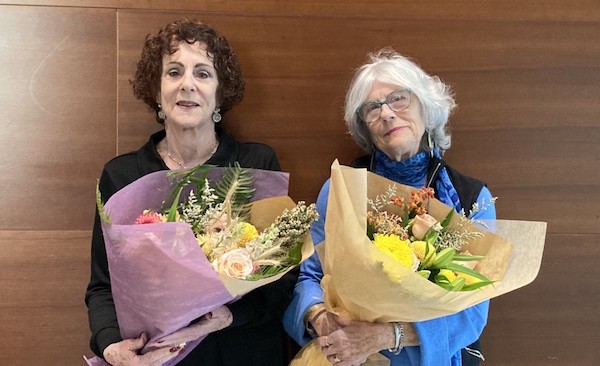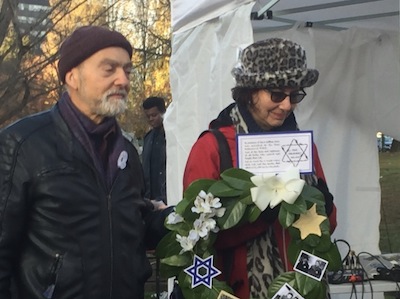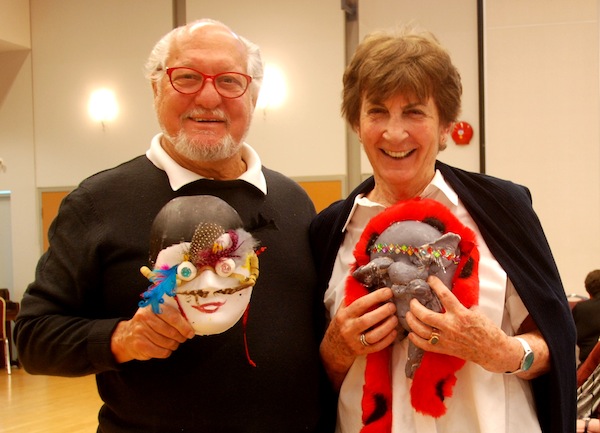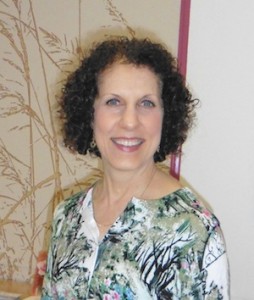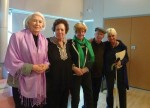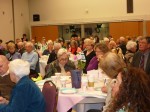Jewish Seniors Alliance honoured volunteers Merle Linde, left, and Gyda Chud for their many years of service. (photo by Rita Propp)
Jewish Seniors Alliance celebrated its 20th anniversary at its Oct. 26 annual general meeting, which took place at Congregation Beth Israel. The meeting was followed by a reception honouring two volunteers, Merle Linde and Gyda Chud, and entertainment was provided by Brock House Big Band, with party sandwiches and dessert by Nava Creative Kosher Cuisine.
The AGM was called to order by JSA president Tammi Belfer, who paid tribute to Serge Haber, who had passed away the previous week. Haber’s family urged JSA to carry on with the proceedings, which included paying respect to all the JSA members who had died in the last year.
The 2022 minutes and the agenda for this year were approved. The president’s report followed and Chud presented a summary of committee reports. Larry Shapiro spoke about the financial position of JSA as of May 31 on behalf of treasurer Alan Marchant, who was unable to attend the meeting. Jerry Bleet gave an update on fundraising plans and the election of directors was presented for the nominating committee by Ken Levitt.
Once the formal part of the afternoon was completed, the 62 members of JSA assembled in the reception area, where tables had been set up and the band was already playing. Brock House Big Band is an 18-piece ensemble whose repertoire comprises a variety of jazz and popular music. Rabbi Adam Stein, a JSA board member, said Hamotzi, so lunch could begin.

Levitt gave another tribute to Haber, emphasizing Haber’s work in creating JSA from scratch, his care and compassion for seniors, and his work with them. Levitt said Haber thrived on challenges. “How many people can say that they created an organization?” asked Levitt.
A video was shared in which Haber talked about the needs of seniors, the importance of dealing with loneliness and isolation, and the need for emotional support.
Michael Lee, MLA for Vancouver-Langara, said a few words. He had met Haber seven years ago at a seniors’ event and Lee praised the work Haber had done in Holocaust education and his efforts in building JSA to serve seniors in British Columbia. Lee thanked the board and staff for the work JSA has done.
Maurice Moses, a longtime personal friend of Haber’s, spoke about singing with Haber and with Saul “Pucky” Pellman and Arnold Selwyn at the Louis Brier Home and at Congregation Beth Israel for many years. He said Haber called him every Friday to say Shabbat Shalom. Moses made reference to “lech l’chah” – literally meaning “Go to yourself,” “go forth,” the essence of our lives and spiritually being within ourselves – and sang a song about it honouring Haber.
Then it was the time to honour the two volunteers.
Linde has been a peer support volunteer since 2005. She is inspired by the humanitarian ideals of tikkun olam(repairing the world) and chesed (acts of kindness) to ensure a safeguard for those who are at a disadvantage. This work is a natural progression for Linde, from her participation for many years in community organizations in both South Africa and Canada.
Charles Leibovitch, coordinator of peer support services, made the presentation to Linde, as Grace Hann, trainer and supervisor of peer support services, was away due to a death in her family. He presented Linde with a bouquet of flowers and a certificate, praising her for the many years of service to the seniors she has supported. Hann sent a note saying that Linde has been a role model for her.
Linde thanked Leibovitch and Hann. Apparently, all four of her clients had been artists and Linde used with them her own artistic skills and artwork. She said people eventually tell you their stories in such an environment and this enables her to offer emotional support.
Marilyn Berger made the presentation to Chud, calling Chud “our star.” She said Chud seems unable to say no and takes a lot on herself. Chud is a past co-president of JSA and presently chairs two committees – peer support, and programs. In her thanks to Berger and the committee, Chud spoke about the three Rs that are important in education and life: relationship, reflection, restorative practice. She ended with JSA’s motto: “Seniors Stronger Together.”
Ezra Shanken, chief executive officer of the Jewish Federation of Greater Vancouver, addressed the group briefly. He said the JSA is important to the community and thanked the organization for their crucial work with seniors.
Entertained by the band, a few people danced. Dessert was served and people chatted with one another and listened to the music. This was the first of several upcoming events that will celebrate JSA’s 20th anniversary.
On Nov. 19, JSA’s fall symposium will present “Serge Haber, A Visionary.” Everyone is welcome to join in a tribute to Haber, whose vision of a kinder future helped shape the Jewish community. For more information, visit jsalliance.org.
Shanie Levin is a life governor of Jewish Seniors Alliance and on the editorial board of Senior Line magazine.

